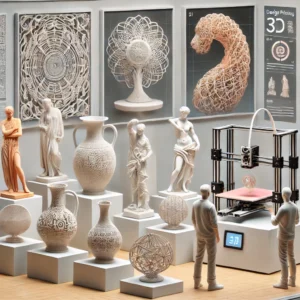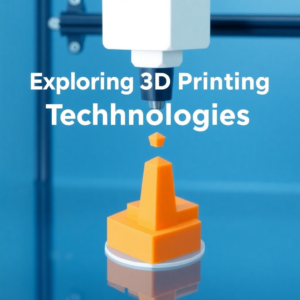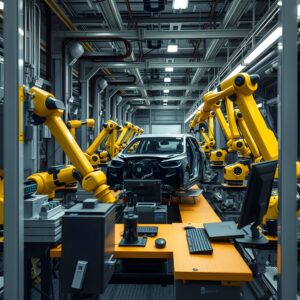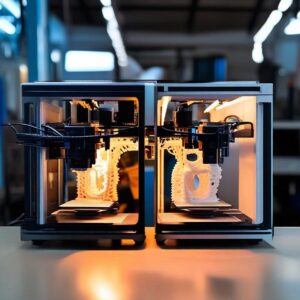3D Printing in the Art and Design Industry

Explore how 3D printing is revolutionizing the art and design world. From sculptures to fashion, this cutting-edge technology is pushing the boundaries of creativity.
The Fusion of Technology and Creativity
Art and design have always been driven by innovation, from the earliest use of pigments in cave paintings to the advent of digital tools like Photoshop and 3D modeling software. Today, a new technological frontier has emerged that is transforming the creative landscape: 3D printing. Once considered the domain of industrial prototyping, 3D printing has become an essential tool for artists and designers eager to push the boundaries of imagination and craftsmanship.
3D printing, also known as additive manufacturing , allows creators to build objects layer by layer from digital designs. It combines unparalleled precision with the potential for unlimited complexity, enabling artists and designers to bring concepts into reality that were once constrained by traditional methods. From creating intricate sculptures to designing innovative fashion, this technology is unlocking new possibilities across the entire creative spectrum.
The appeal of 3D printing lies in its seamless integration of form, function, and imagination. Artists are no longer restricted by what they can carve, mold, or weld by hand. Instead, they can design digitally and print their creations exactly as envisioned. Meanwhile, designers can prototype and craft products with intricate geometries impossible to achieve through conventional manufacturing. The result is a direct bridge between concept and creation.
In 2024, most creative industries recognize 3D printing’s ability to empower artists and designers with freedom and flexibility. From large-scale installations to wearable art, additive manufacturing has become a go-to method for experimental projects. Its applications even extend to architecture, sustainable design, and film, proving how versatile this technology has become in reshaping both physical objects and creative workflows.
This article explores how 3D printing is revolutionizing the art and design industry. It dives into its influence on creativity, key real-world applications, its challenges, and what the future holds for this ever-evolving marriage of technology and artistic expression.
3D Printing as a Tool for Creative Freedom
One of the most significant advantages of 3D printing for artists and designers is the unprecedented freedom of creation it provides. Traditional art and design techniques—whether sculpting with clay, welding metal, or cutting fabrics—are inherently limited by physical constraints. However, 3D printing removes these restrictions, allowing creators to work with previously unimaginable shapes, textures, and geometries. This has led to a paradigm shift in how designers approach their craft.
In the realm of sculpture, for example, artists can now design highly detailed and intricate forms that would be impossible to sculpt by hand. 3D printing can produce objects with fine textures, cellular structures, or interlocking elements, opening up a wealth of opportunities for experimentation. For instance, designs inspired by nature—such as fractals, coral-like growths, or honeycomb lattices—can be created with ease using additive manufacturing.
Customization is another hallmark of 3D printing that has taken the art world by storm. Artists and designers can now personalize their output with extraordinary precision. Whether it’s a bespoke jewelry piece tailored to an individual client or a site-specific art installation perfectly calibrated to its surroundings, the ability to iterate and adjust designs empowers creators like never before. This degree of customization keeps their work truly unique and deeply resonant.
Moreover, this technology encourages cross-disciplinary experimentation , allowing artists to blend traditional mediums with cutting-edge techniques. Digital sculptors, for example, can 3D print their designs and then refine them by hand-painting or adding additional materials. Conversely, traditional sculptors can scan their works into digital formats and enhance them using computer-aided design (CAD) software before reprinting. This marriage of analog and digital has blurred the lines between traditional craftsmanship and modern technology.
In many ways, 3D printing has redefined the creative process itself. Instead of thinking in terms of what physical tools can achieve, designers now start with the digital canvas, letting their imagination drive their creations. This reinvention of workflows has given birth to new art movements and design philosophies centered around boundless creativity and thinking beyond physical constraints.
Key Applications of 3D Printing in Art and Design
The applications of 3D printing in the art and design industry are as diverse as they are revolutionary. From high-concept art installations to functional product design, artists and designers across disciplines are discovering unique ways to integrate this technology into their work. Each application reflects the versatility and transformative impact of additive manufacturing.
One of the most popular applications of 3D printing in fine art is the creation of sculptures and installations. Artists can print large, intricate sculptures that would be impractical or impossible to produce using traditional methods. For example, artist Isaie Bloch has gained international recognition for his surrealist 3D-printed sculptures that combine organic forms with futuristic aesthetics. Such works demonstrate how 3D printing enables groundbreaking visual storytelling.
In the fashion and jewelry industries, 3D printing has radically changed how designers approach wearable art. Renowned designer Iris van Herpen incorporates 3D-printed elements into her couture collections, turning runway pieces into living works of art. Similarly, jewelry designers routinely harness the ability to print intricate metal and resin patterns, reducing production costs while elevating craftsmanship. This enables avant-garde plays in light, structure, and material.
Interior design has also embraced 3D printing for creating bespoke furniture, lighting fixtures, and décor. One standout example is the 3D-printed Mobius chair , an iconic piece of furniture admired for its flowing, infinite-loop shape. Customization also shines here—clients can request personalized furniture tailored to match their specific aesthetic preferences or functional needs, adding a personal touch to every interior.
In architecture , additive manufacturing is being used to create intricate building models, large-scale façade panels, and even experimental habitable structures. For example, some projects have used 3D-printed concrete to fabricate sustainable housing concepts. This allows architects to achieve creative, organic forms that optimize both structural integrity and visual beauty.
Finally, enthusiasts in the film and entertainment industry have embraced 3D printing to create unique props, costumes, and set pieces. Intricate helmets, alien sculptures, and entire environments are now built using additive methods, drastically reducing production timelines while enabling unparalleled levels of detail. Movies like Iron Man and The Mandalorian famously relied on 3D printing for costume design, blending functional production with cinematic wonder.
For other insights and projects, be sure to explore our Key Technologies in 3D Printing or Uses of 3D Printing column




